Office of Research & Development |
 |

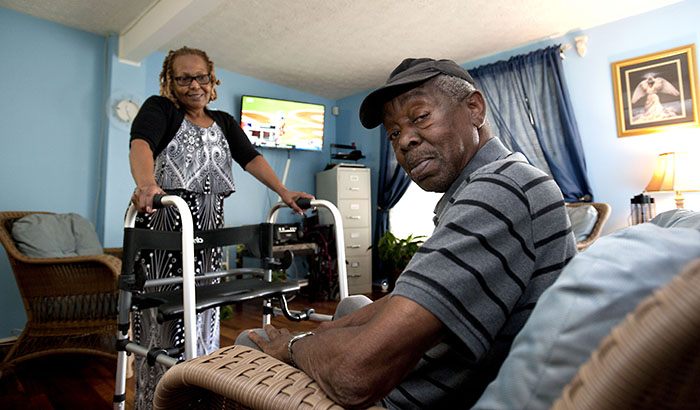
Registered nurse Anita Wilkens has turned her home into a VA medical foster home, in which she provides 24/7 skilled care for James Burgess and two other Veterans. (Photo by Robert Turtil)
October 3, 2019
By Mitch Mirkin
VA Research Communications
"There was a very consistent theme that they [the Veterans] were part of the family."
Having served stateside as an Army medic during the Vietnam era, James Burgess knows a thing or two about caring for others. But nowadays, the 79-year-old stroke survivor is in need of care himself.
Many older people with Burgess’ medical needs would end up in a nursing home. Burgess and his daughter opted, instead, for him to receive long-term care in a VA medical foster home.
JB, as he likes to be known, lives in the cozy, well-maintained home of registered nurse Anita Wilkens. He occupies one of three upstairs bedrooms in the compact townhouse, on a quiet suburban street outside of Baltimore. The other bedrooms house two other Veterans, each with his own health care needs.
JB, who ran a plumbing business for more than three decades and drove a cab after he retired, seems content, despite his health challenges. On a recent summer day, he was getting ready to go out on a fishing trip with a VA recreational therapist and a few other Veterans. He enjoys playing with Wilkens’ toy poodle, Wiggles, and watching sports on the large-screen TV in the living room. Two days a week, he goes to a VA-contracted adult day health center, where he likes to play cards and checkers.

VA ear surgeon studies management of severe hearing loss in Veterans
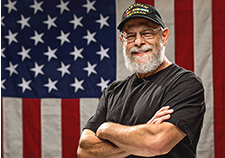
Veteran disability payments led to fewer hospitalizations
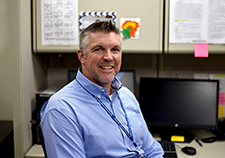
Air Force Veteran among 10 new awardees in VA diversity, equity, and inclusion research program
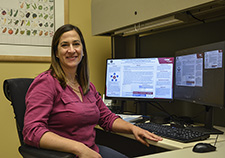
VA researcher leads project to evaluate Veteran screening for malnutrition
If there’s something on the menu not to his liking, that can be easily adjusted, more so than in a conventional nursing home. Wilkens says she tries to arrange it so her three residents eat together whenever possible. “That way they can talk with each other.”
As typical as JB’s experiences might be in the VA medical foster home program, there’s more than anecdotal evidence backing the effectiveness of this model of care.
The program is a sensible way to deliver 24/7 long-term care, says Dr. Cari Levy, who has published studies on it. Levy heads palliative care at the Denver VA Medical Center and is the associate director of the Center of Innovation for Veteran-Centered and Value-Driven Research.
For example, a study her group published earlier this year found medical foster homes to be less costly than traditional nursing home care. The difference was about $71 per day per Veteran. Even when the monthly fees paid by Veterans were factored in, the foster home model was no more expensive.
The study also showed a trend toward better survival among Vets living in such homes, relative to Vets with similar health and demographic profiles living in nursing homes.
Her team concluded that “efforts to expand the medical foster home program appear warranted given that the program adds to the array of long-term-care options for persons in need of nursing home care while achieving cost-savings and a mortality advantage when compared to traditional community nursing home care.”
The program has been around since 2008. Levy says that to understand how VA medical foster homes work, you first have to understand VA’s home-based primary care program, or HBPC. The two programs are closely linked.
“HBPC is essentially for Veterans who are too sick to go to clinic,” she says. “Clinic can be a burdensome activity because of functional disability or just the physical and medical issues that are going on. It can be quite taxing—being driven to the clinic, waiting for appointments, the drive back home.
“HBPC wraps all of the primary care around the Veteran in their own home. It involves all the disciplines that are needed. The idea is to bring most of that primary care to the home. Technology can also help—a tablet, phone calls.”
She calls it “Cadillac care” because of the quality. “These are dedicated, highly qualified clinicians coming to your home.”
With the medical foster home, she says, “instead of bringing all of that care to the Veteran’s home, we’re bringing it to a foster home.”
Foster caregivers approved by VA can care for up to three individuals in their home. No more. The goal is to maintain a homelike atmosphere.
There are variations in how the program works, depending on which state is involved. In Maryland, for example, VA approves foster homes only once they’re already licensed by the state as assisted-living facilities. That is the designation given to these homes, even though the level of care they’re providing to Veterans is more in line with what nursing homes offer.
In any case, they’ve already gone through a rigorous inspection. The state mandates a long list of safety features—even fire drills—and appropriate training for staff. In Wilkens’ case, she is helped out by a few family members, including one daughter who’s a certified nursing assistant and another who’s a registered nurse, like herself.
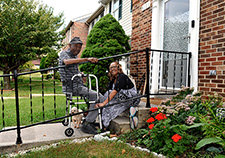
Burgess and Wilkens enjoy the outdoors on the front porch of her suburban Baltimore townhouse. (Photo by Robert Turtil)
VA social worker Nicole Trimble oversees the MFH in six Maryland counties and Baltimore City.
“Before we’ll even consider a home, they have to have gone through the state process first,” she explains.
She emphasizes that “you’re never going to have any more than three residents in the home, really keeping with the mission of the program, which is to provide a homelike atmosphere where you’re getting the extensive care you need to maintain yourself in the community, versus being in a nursing home or in a more institutionalized assisted-living facility.”
One of JB’s housemates is a fellow Veteran who is in his 50s but depends on a left ventricular assistive device, a surgically implanted pump for patients in end-stage heart failure. Trimble says that attests to the level of care provided in VA MFHs.
A Vet living in one of the other homes she oversees is 98 years of age and on hospice care. “He’s in the home that he’s been in in for months, and he doesn’t have to leave,” says Trimble. “He left his own home to come into a medical foster home. I can’t help but wonder if the outcome would have been different if he had to go to a nursing home.”
Conventional nursing homes are covered under VA benefits for eligible Veterans. Veterans in MFHs need to pay out of pocket, around $2,500 to $3,000 per month, but typically they are able to apply various benefits to help cover the cost, or at least most of it. Levy says pending legislation may enable Veterans to apply their conventional VA nursing home benefits, and perhaps even their Medicare benefits, toward VA MFH care. She hopes her research, particularly on cost-effectiveness, has helped strengthen the case for those proposals.
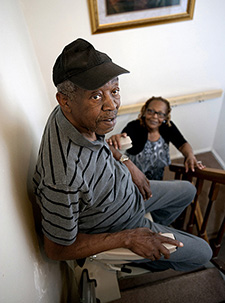
A powered stair climber provided by VA helps Burgess get to his second-floor bedroom. (Photo by Robert Turtil)
Her qualitative studies, which have included interviews at several MFHs with residents and caregivers, paint a picture of warm, family-style care.
“There was a very consistent theme that they [the Veterans] were part of the family,” says Levy. “They were at dinner. They were at breakfast. They kids were in the household and the dog was there. All the events that happened with the family were involving the Veterans. There were all the lovely conversations. The highs and lows that happened with families were happening for these Veterans because they were in the home.”
The caregivers in the MFH program get paid—it’s a fulltime job for the primary caregiver, in fact—but they also do it as a calling, says Trimble.
“The money helps, but this is not easy work. They enjoy caring for people, and for Veterans especially. One of our caregiver teams, it’s a man and a woman, and the gentleman is a Korean War Veteran wanting to give back and take care of his fellow Veterans.”
Wilkens, for her part, says the MFH program is an extension of her nursing career. “I worked with Alzheimer’s patients. I was in geriatrics my whole career. Taking care of people is something I like doing.”
Ask JB how he came to live at Wilkens’ home, and he’ll tell you how his daughter and her daughter grew up together and remained friends. There was already a family bond.
“I took care of both my parents before they passed away,” shares Wilkens. “His daughter called me and said, ‘I watched how you took care of your Dad, and I was wondering if you could take care of mine.’ That made me feel real good.”
VA Research Currents archives || Sign up for VA Research updates